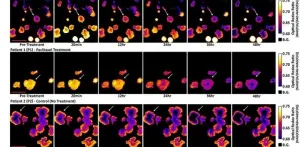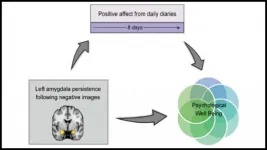Focusing on the unhealthy brain to speed drug discovery
University of Houston collaboration with National Institutes of Health delivers toolkit to accelerate process
2021-03-22
(Press-News.org) Though 40 million concussions are recorded annually, no effective treatment exists for them or for many other brain-related illnesses. In collaboration with Dragan Maric of the National Institutes of Health, Badri Roysam, Hugh Roy and Lillie Cranz Cullen University Professor and Chair of Electrical and Computer Engineering, and his team are working to speed up drug development to treat brain diseases and injuries like concussion by developing new tools.
"We are interested in mapping and profiling unhealthy and drug-treated brain tissue in unprecedented detail to reveal multiple biological processes at once - in context," said Roysam about his latest paper published in Nature Communications. "This requires the ability to record high-resolution images of brain tissue covering a comprehensive panel of molecular biomarkers, over a large spatial extent, e.g., whole-brain slices, and automated ability to generate quantitative readouts of biomarker expression for all cells."
At the National Institute of Neurological Disorders and Stroke, Maric developed the innovative imaging technique that can be readily implemented for widespread use with the potential to transform brain studies requiring comprehensive cellular profiling from single and serial slices of brain tissue. Roysam's lab developed the computational image analysis methods based on deep neural networks. Roysam's system analyzes the images on the UH supercomputer automatically and can reveal multiple processes at once - the brain injury, effects of the drug being tested and the potential side effects of the drug.
"Compared to existing screening techniques, using iterative immunostaining and computational analysis, our methods are more flexible, scalable and efficient, enabling multiplex imaging and computational analysis of up to 10 - 100 different biomarkers of interest at the same time using direct or indirect IHC immunostaining protocols," reports Roysam. The new toolkit uses repeated cycles of optimized 10-plex immunostaining with 10-color epifluorescence imaging to accumulate highly enriched image datasets from individual whole-brain slices, from which seamless signal-corrected mosaics are reconstructed and analyzed.
This makes way for more rapid drug development. "We present a direct method that generates readouts for a comprehensive panel of biomarkers from serial whole-brain slices, characterizing all major brain cell types, at scales ranging from subcellular compartments, individual cells, local multi-cellular niches, to whole-brain regions from each slice," said Roysam.
The open-source toolkit approach is also adaptable to other tissues. Its development can accelerate systems-oriented studies by providing quantitative profiles of all the molecular and cellular players at once, in their detailed spatial context.
"We are efficiently overcoming the fluorescence signal limitations and achieving highly enriched and high-quality source imagery for reliable automated scoring at scale. Our goal is to accelerate system-level studies of normal and pathological brains, and pre-clinical drug studies by enabling targeted and off-target drug effects to be profiled simultaneously, in context, at the cellular scale," said Roysam.
INFORMATION:
The team's work is supported by a $3.19 million grant from the NIH.
[Attachments] See images for this press release:

ELSE PRESS RELEASES FROM THIS DATE:
2021-03-22
NEW YORK, NY (March 22, 2021)--The first year of the COVID-19 pandemic has taken the lives of millions of people around the world but has also left hundreds with lingering symptoms or completely new symptoms weeks after recovery.
Much is unknown about what causes these symptoms and how long they last. But with nearly 740,000 cases of COVID reported in New York City since last March--and 28 million in the United States--physicians are increasingly seeing these "long-haulers" in their practices.
"Over the course of the summer, we started getting a sense of what issues these people were having," ...
2021-03-22
Organoids are tiny three-dimensional cellular assemblies that are grown in a laboratory from tissue-specific cells. They are particularly interesting to biologists because of their ability to mimic the characteristics of the original tissues. If scientists extract cells from a tumor, then they can grow cancer organoids that mimic the characteristics of the source tumor.
This possibility for individual-level studies of tumor properties makes cancer organoids an exciting tool from the perspective of an emerging field called precision cancer medicine. Daniel Gil of the University of Wisconsin ...
2021-03-22
CLEVELAND--A new technique for sampling and testing cells from Barrett's esophagus (BE) patients could result in earlier and easier identification of patients whose disease has progressed toward cancer or whose disease is at high risk of progressing toward cancer, according to a collaborative study by investigators at Case Western Reserve University and Johns Hopkins Kimmel Cancer Center (JHKCC).
Published in the journal Gastroenterology, the findings show the combination of esophageal "brushing" with a massively parallel sequencing method can provide an accurate assessment of the ...
2021-03-22
For something we spend one-third of our lives doing, we still understand remarkably little about how sleep works -- for example, why can some people sleep deeply through any disturbance, while others regularly toss and turn for hours each night? And why do we all seem to need a different amount of sleep to feel rested?
For decades, scientists have looked to the behavior of the brain's neurons to understand the nature of slumber. Now, though, researchers at UC San Francisco have confirmed that a different type of brain cell that has received far less study -- astrocytes, named for their star-like shape -- can influence how long and how deeply animals sleep. The findings could open new avenues for exploring sleep disorder therapies and help scientists better understand brain diseases linked ...
2021-03-22
A large study of brain MRI scans from 11,679 nine- and ten-year-old children reviewed by UC San Francisco neuroradiologists identified potentially life-threatening conditions in 1 in 500 children, and more minor but possibly clinically significant brain abnormalities in 1 out of 25 children.
The results provide the best estimates to date of the true incidence of various structural abnormalities in the developing brain, and raise the question of whether all MRI brain imaging obtained during research studies should be reviewed by board-certified radiologists, as was done in this study, in the hopes of saving lives and alerting participants to incidental findings that ought to be medically evaluated.
One ...
2021-03-22
How the amygdala responds to viewing negative and subsequent neutral stimuli may impact our daily mood, according to new research published in JNeurosci.
The amygdala evaluates the environment to find potential threats. If a threat does appear, the amygdala can stay active and respond to new stimuli like they are threatening too. This is helpful when you are in a dangerous situation, but less so when spilling your coffee in the morning keeps you on edge for the rest of the day.
In a recent study, Puccetti et al. examined data collected from the "Midlife ...
2021-03-22
MINNEAPOLIS/ST.PAUL (03/22/2021) -- New research from the University of Minnesota Medical School suggests that disease-driving B cells, a white blood cell, play a role in the development of non-alcoholic fatty liver disease (NAFLD) - the most common chronic liver condition in the U.S. Their findings could lead to targeted therapies for NAFLD, which currently affects a quarter of the nation and has no FDA-approved treatments.
After noticing that patients with the disease showed a large number of inflammatory B cells in their livers, Xavier Revelo, PhD, an assistant professor in the Department of Integrative Biology and Physiology and senior author, began studying B cells in NAFLD.
"This disease is increasing in prevalence ...
2021-03-22
Although Tuberculosis, or TB, killed nearly as many people as COVID-19 (approx. 1.8 million) in 2020, it did not receive as much media and public attention. The pandemic has proven that transmissible infection is indeed a global issue. TB remains a serious public health concern in Ireland, particularly with the presence of multi-drug resistant types and the numbers of complex cases here continuing to rise, with cases numbering over 300 annually.
Science tells us that iron is crucial for daily human function, but it is also an essential element for the survival of ...
2021-03-22
Batteries charge and recharge--apparently all thanks to a perfect interplay of electrode material and electrolyte. However, for ideal battery function, the solid electrolyte interphase (SEI) plays a crucial role. Materials scientists have now studied nucleation and growth of this layer in atomic detail. According to the study published in the journal Angewandte Chemie, the properties of anions and solvent molecules need to be well balanced.
In lithium-ion batteries, the SEI forms at the beginning of the first charging process, when a potential is applied. Elements from the electrolyte deposit on the graphite electrode and form a coating that soon ...
2021-03-22
Antibiotics have revolutionized the field of medicine by making it possible to treat most known microbial diseases today. However, their uncontrolled usage has led to the major global problem of antibiotic resistance. As we continue to exploit antibiotics, sometimes at doses much higher than needed, disease-causing bacteria are rapidly evolving defense strategies to evade them. These drug-resistant bacteria, also known as "superbugs," cause severe infections that are difficult to treat and can eventually be fatal.
Methicillin-resistant Staphylococcus aureus (MRSA), a particularly vicious group of superbugs that have developed resistance to the antibiotic methicillin, is a major cause of hospital-acquired infections. Accurate and timely diagnosis ...
LAST 30 PRESS RELEASES:
[Press-News.org] Focusing on the unhealthy brain to speed drug discovery
University of Houston collaboration with National Institutes of Health delivers toolkit to accelerate process



